Chinese porcelain is more than just dinnerware; it is a profound testament to a civilization’s artistic and technological genius. Among the great periods of Chinese ceramic history, the Qing Dynasty ceramics (1644–1911) stand out as the pinnacle of refinement and diverse innovation. In this article, we’ll uncover the origin, development, and beauty of Qing Dynasty ceramics, tracing the legacy of Chinese ceramics from the Paleolithic period through the Qing dynasty.
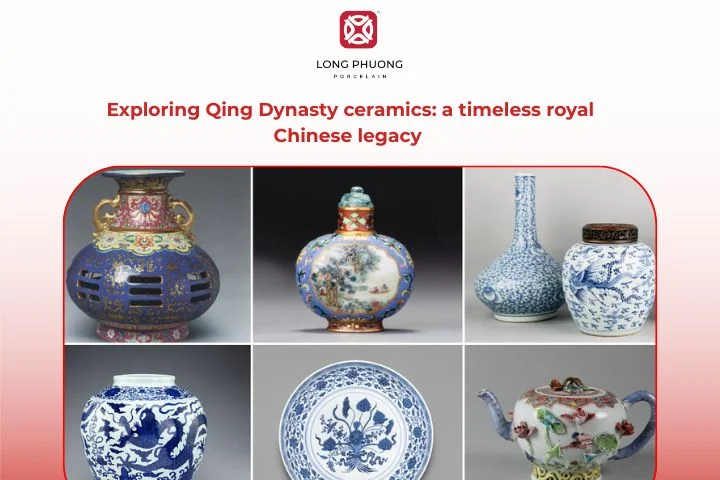
1. What was the Qing dynasty porcelain?
The Qing dynasty (1644–1912) was China’s last imperial dynasty, known for its flourishing arts and global trade. Porcelain from this period reflected both imperial power and aesthetic sophistication. Backed by strong royal patronage, artisans perfected their techniques at the famous Jingdezhen kilns, often called the “Porcelain Capital of the World.”

Qing porcelain was produced for three main markets:
- Imperial Wares: Commissioned directly by the court, these were the finest pieces, bearing specific reign marks and designs.
- Domestic Market Wares: High-quality ceramics for the Chinese elite and general populace.
- Export Wares: Massive quantities produced to meet the immense demand from Europe and other foreign markets, often incorporating Western shapes or decorative elements.
The shift in decorative taste toward bright colors, complex scenes, and flawless finishing distinguishes Qing Dynasty ceramics from its predecessors, solidifying its place as a cornerstone of global ceramic art.
See more: italian pottery marks identification guide for collectors
2. The legacy of Chinese ceramics from the Paleolithic period through the Qing Dynasty
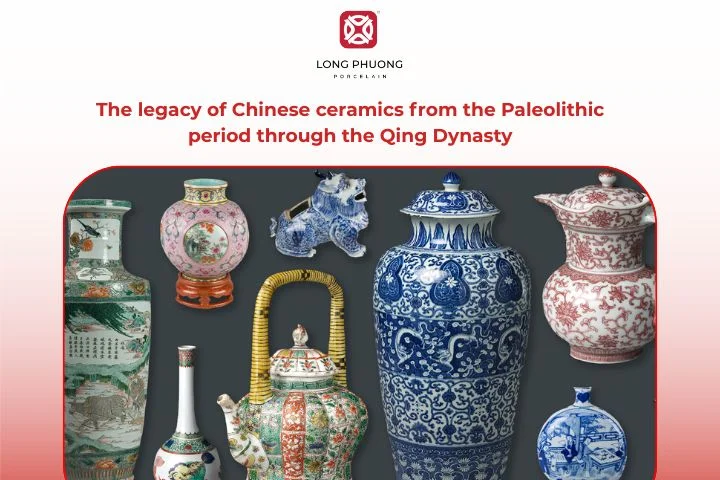
To truly appreciate the significance of Qing Dynasty ceramics, one must look back at the entire journey of Chinese ceramics from the Paleolithic period through the Qing dynasty:
- Paleolithic/ Neolithic Period (c. 18,000 BCE – c. 2000 BCE): The earliest forms of pottery emerged, mainly utilitarian earthenware decorated with geometric or painted designs (e.g., Yangshao culture).
- Dynastic Beginnings (Shang/ Zhou Dynasties): Advances in kiln technology led to improved strength and forms, introducing early glazes.
- Han Dynasty (206 BCE – 220 CE): The development of lead-based glazes, often in green, and sophisticated tomb figures (mingqi).
- Tang Dynasty (618–907): Famous for Sancai (“three-color”) lead-glazed earthenware and the birth of true high-fired porcelain.
- Song Dynasty (960–1279): The “golden age” of subtle, monochromatic glazes, focusing on elegant forms (e.g., Celadon, Ding ware).
- Yuan Dynasty (1271–1368): The maturity of Blue-and-White porcelain following the introduction of cobalt from the Middle East.
- Ming Dynasty (1368–1644): The establishment of Jingdezhen as the central ceramic hub, known for its powerful, often less delicate, Blue-and-White and Wucai (“Five-Color”) wares.
The Qing Dynasty inherited all this knowledge, perfected the techniques, and, importantly, introduced brilliant new color palettes and glazes that were technically superior to those of the Ming. This vast historical context underscores that Qing Dynasty ceramics were not an isolated event but the ultimate refinement of a deep, unbroken artistic lineage.
3. Characteristics of Qing Dynasty ceramics
Each piece of Qing Dynasty ceramics tells a story – of technique, design, and imperial ambition. Let’s explore their defining characteristics.
3.1. Glaze types
The Qing era introduced an impressive range of glazes. Notable examples include:
- Famille Verte (Kangxi period) – Featuring vivid green, yellow, and iron-red enamels.
- Famille Rose (Yongzheng and Qianlong periods) – Characterized by soft pinks and pastels made possible by imported European pigments.
- Monochrome glazes – Such as celadon, oxblood (sang-de-boeuf), and sky-blue, achieved through precise temperature control.
- Cloisonné enamel porcelain – A fusion of metalwork and porcelain artistry, often reserved for imperial use.
These innovations elevated Qing Dynasty ceramics to an unmatched level of artistry and precision.

3.2. Shapes and forms
Qing potters were masters of form, often producing complex shapes that required immense technical skill. Shapes ranged from traditional Chinese forms to new ones tailored for the export market.
- Meiping – A plum vase with a narrow neck and broad shoulders.
- Gu – A tall beaker form inspired by ancient bronze vessels.
- Moon flasks – Flattened circular forms with twin handles, favored by the Qianlong Emperor.
Each silhouette symbolized grace and balance, embodying the aesthetic ideals of the time.
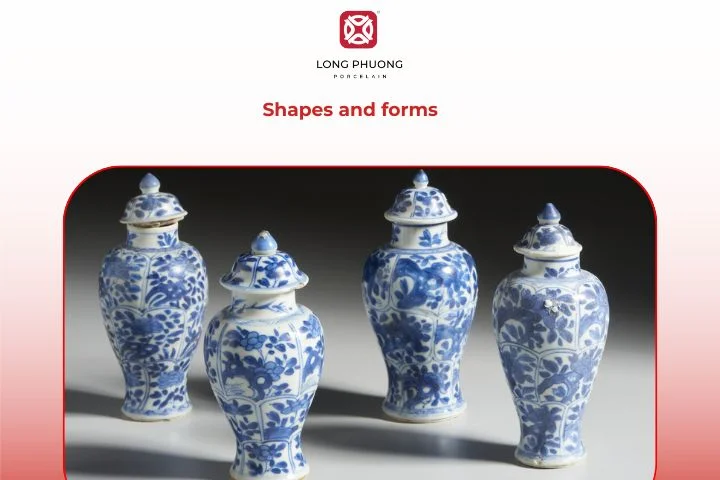
3.3. Decorative motifs and patterns
Decoration in Qing porcelain blended symbolism and storytelling. Artisans painted scenes from nature, folklore, and imperial life. Popular motifs included:
- Dragons and phoenixes – Symbols of power and harmony.
- Lotus and peony flowers – Representing purity and prosperity.
- Clouds, waves, and mountains – Reflecting balance between nature and humanity.
- Calligraphic inscriptions – Poems, blessings, or imperial reign marks to indicate authenticity.
These motifs transformed ceramics into poetic masterpieces, each carrying a message of cultural pride.

4. What is the difference between Qing dynasty and Ming porcelain?
While both Ming and Qing porcelains are celebrated globally, they reflect distinct eras and aesthetics.
| Aspect | Ming Dynasty (1368–1644) | Qing Dynasty (1644–1912) |
| Color palette | Dominated by blue-and-white cobalt designs | Expanded with famille rose, verte, and polychrome enamels |
| Style | Simpler, bold, and symmetrical | More elaborate, detailed, and experimental |
| Technique | Early mastery of underglaze blue | Innovation in overglaze enameling and multi-color glazing |
| Purpose | Court and export wares | Both imperial commissions and global trade pieces |
| Influence | Rooted in Chinese traditions | Blended Chinese and Western aesthetics |
In short, Ming porcelain laid the foundation, while Qing porcelain elevated artistry to new heights of creativity and refinement.
5. How to identify authentic Qing dynasty ceramics

Identifying genuine Qing dynasty ceramics requires knowledge, keen observation, and sometimes expert analysis. Here are key indicators:
- Reign marks: Genuine Qing pieces often bear six-character reign marks (e.g., “Da Qing Qianlong Nian Zhi”).
- Texture and weight: Authentic porcelain feels smooth and well-balanced — not overly heavy.
- Glaze quality: Real Qing glazes have depth, a sense of translucency, and no artificial shine.
- Brushwork: Designs should appear fluid and natural, with clear brushstrokes rather than printed patterns.
- Aging signs: Look for subtle wear around the base and rim — natural aging, not artificial distressing.
For collectors, consulting specialists or museum references is essential before making purchases.
6. Video: How to identify authentic Qing dynasty ceramics
7. FAQs
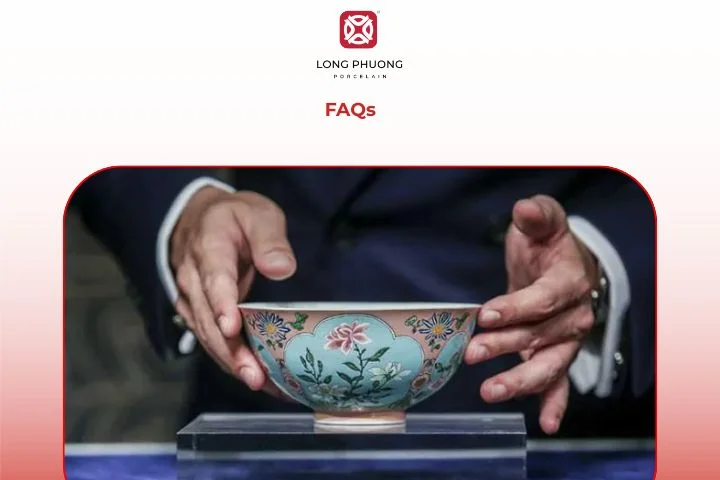
7.1. Is Qing Dynasty ceramics valuable?
Yes. Authentic Qing porcelain pieces can be extremely valuable, sometimes worth millions at auctions. Their rarity, historical significance, and craftsmanship make them prized collectibles.
7.2. Which dynasty is famous for ceramics and pottery?
While many dynasties contributed to China’s ceramic heritage, the Tang, Song, Ming, and Qing dynasties are especially renowned for innovation and artistry.
7.3. What are the most valuable Chinese pottery marks?
The most valuable marks are typically the six-character reign marks of the most revered emperors, particularly:
– Yongle (Ming Dynasty)
– Xuande (Ming Dynasty)
– Chenghua (Ming Dynasty)
– Kangxi (Qing Dynasty)
– Yongzheng (Qing Dynasty)
– Qianlong (Qing Dynasty)
Remember: a mark is only a small part of authentication. The quality, age, and style of the piece must match the mark to be genuinely valuable.
7.4. Is there an app that identifies pottery?
Yes. Modern technology offers image-based identification apps that can help enthusiasts recognize patterns or marks, but expert appraisal remains the most reliable method.
7.5. How do you know if old china is worth anything?
The value of old china is determined by four main factors:
– Rarity: How many similar pieces are known to exist?
– Condition: Is it free from chips, cracks, restoration, or significant wear?
– Aesthetics: Is the decoration of high quality? Is the form pleasing?
– Provenance: Can its history of ownership be traced back to a reputable collection? For Qing Dynasty ceramics, the provenance of a piece being genuinely imperial is the fastest route to extreme value.
7.6. What year marked the beginning of the Qing dynasty?
The Qing Dynasty began in the year 1644. It succeeded the Ming Dynasty and was overthrown in 1911, leading to the establishment of the Republic of China.
8. Where to buy premium quality porcelain?
If you admire the timeless elegance of Qing Dynasty ceramics but prefer modern durability and design, explore Long Phuong Porcelain – Vietnam’s leading manufacturer of high-quality tableware and decorative ceramics.
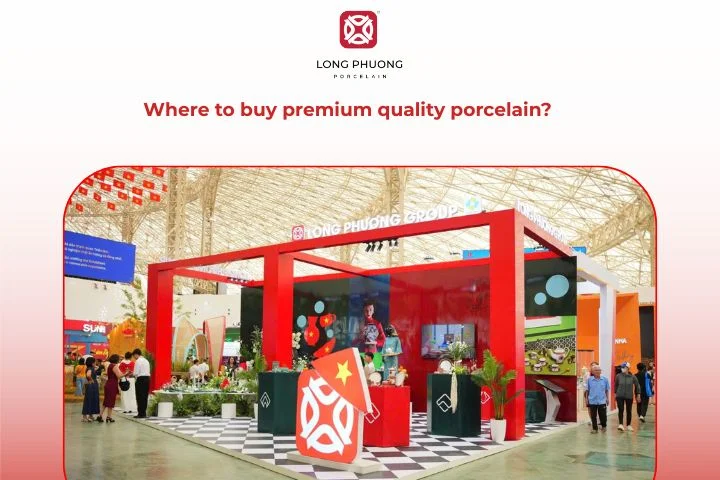
At Long Phuong, every product combines Asian artistry with contemporary craftsmanship. From fine dining sets to elegant gift collections, each piece embodies harmony, durability, and sophistication – reminiscent of the imperial porcelains that once graced royal tables.
Whether you’re curating a collection, decorating your home, or seeking the perfect gift, Long Phuong Porcelain offers premium-quality ceramics designed to last for generations.
Related Posts
- What is a ceramic kiln and how does it work?
- Top trends in ceramic home decor for modern living spaces
- Difference between ceramic artware and functional ceramics
- Japanese bizen pottery: history and unique firing techniques
- What is ceramic processing and how does it work?
- The history and beauty of vietnamese ceramics
CEO of Long Phuong Group Joint Stock Company, with more than 20 years of exploration and research to obtain the best formulas and professional experience, Long Phuong Porcelain has produced more than 400 designs of all kinds of household porcelain, Significant contributions to Vietnam's ceramic industry.
 Vietnam
Vietnam
